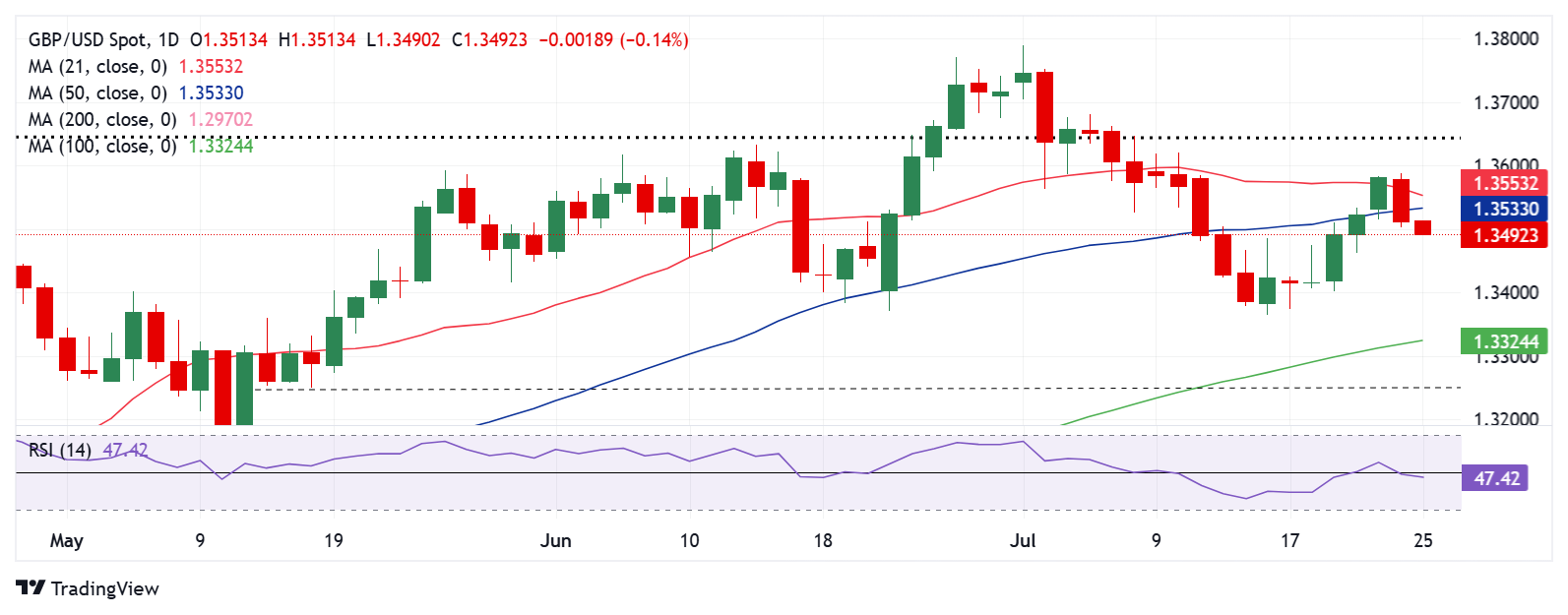
- The Pound Sterling booked a weekly gain as the US Dollar resumed its downtrend.
- GBP/USD traders brace for a data-heavy US calendar, while trade headlines will continue to be in focus.
- Technically, the bias has turned in favor of GBP/USD sellers, with the daily RSI flipping bearish.
The Pound Sterling (GBP) staged a solid comeback from two-month lows against the US Dollar (USD) before GBP/USD buyers ran into the 1.3600 hurdle.
Pound Sterling recovery has lost traction
Despite its retracement in the second half of the week, the GBP/USD pair closed the week with gains as the USD registered its biggest weekly drop in a month.
The Greenback hit its lowest level in two weeks against major currency rivals as easing trade tensions diminished its appeal as a safe-haven asset.
Investors cheered US trade deals with Japan, Indonesia, and the Philippines while staying hopeful that an agreement between the US and the European Union (EU) will be reached soon.
Citing officials from the European Commission, the Financial Times reported on Wednesday that the EU and US are closing in trade deal that would impose 15% tariffs on European imports, while waiving duties on some items.
Progress on trade deals also raised market hopes for fresh US talks with China, especially after Treasury Secretary Scott Bessent said officials of both countries would meet in Stockholm next week to discuss an extension of the deal negotiation deadline.
Meanwhile, risk appetite also got a further boost from the record rally on Wall Street indices, following results by Google parent Alphabet, which beat estimates to kick off the “Magnificent Seven” earnings season.
The broader market optimism, combined with the USD downfall, propelled the higher-yielding Pound Sterling. This, in turn, pushed up GBP/USD to eight-day highs of 1.3584 midweek.
Subsequently, the pair embarked on a reversal mode as the US currency looked to regain lost ground amid reviving safe-haven demand in the latter part of the week.
The decade-long military conflict between Thailand and Cambodia re-ignited on Thursday, while traders turned anxious ahead of US President Donald Trump’s rare visit to the Fed headquarters.
Although markets shrugged off the presidential visit, the Asian military clash continued to weigh on risk sentiment.
The neighbours are locked in a bitter spat over an area known as the Emerald Triangle, where the borders of both countries and Laos meet, and which is home to several ancient temples.
Investors remain worried that the clash between these two countries does not translate into a wider regional conflict.
Both Asian nations requested the United Nations Security Council to convene an emergency meeting on Friday, according to China’s CCTV News.
The Pound Sterling also felt the heat from a surprise slowdown in the UK services sector in July. The seasonally adjusted S&P Global/CIPS UK Services Purchasing Managers’ Index (PMI) unexpectedly dropped to 51.2 in July, versus June’s 52.8, while coming in below the anticipated 53 figure.
The Office for National Statistics (ONS) said on Friday, UK Retail Sales rebounded less than expected in June, arriving at 1.7% annually and 0.9% on the month.
The market expectations were for an increase of 1.8% and 1.2%, respectively, in the reported period. British Retail Sales data also added to the pair’s downside.
US Durables Goods Orders data
Watch out for the August 1 tariff deadline and US event risks
With the August 1 Trump tariff deadline approaching, GBP/USD traders prepare for a spate of top-tier economic events from the United States (US) in the upcoming week for fresh trading incentives.
Monday is devoid of any significant data releases from both sides of the Atlantic, and hence, eyes turn to Tuesday’s US JOLTS Job Openings Survey and the Conference Board (CB) Consumer Confidence data.
On Wednesday, the advance estimate of the second-quarter US Gross Domestic Product (GDP) will hog the limelight ahead of the July policy announcements by the Fed. The US central bank is widely anticipated to hold interest rates when it concludes its two-day policy meeting on July 30.
Friday’s US Nonfarm Payrolls (NFP) for July and the ISM Manufacturing PMI data will be on the cards. However, the focus will also be on trade developments on the tariff deadline cut-off day.
Apart from data publications, markets will scrutinize speeches from Fed policymakers on Friday as the US central bank’s ‘blackout period’ ends on Thursday.
GBP/USD: Technical Outlook

The daily chart shows that the GBP/USD pair failed to resist above the short-term 21-day Simple Moving Average (SMA), then near 1.3575, and came under intense selling pressure.
The renewed downside prompted the major to breach the 50-day SMA support at 1.3530, initiating a fresh downtrend.
The next strong support is seen at the July 16 low of 1.3365, below which the 1.3325-1.3300 demand area will be tested. That zone is the confluence of the 100-day SMA and the round level.
The mid-May low near 1.3250 could emerge as a tough nut to crack for sellers.
The 14-day Relative Strength Index (RSI) points lower below the midline, currently near 47, suggesting that sellers will likely retain control going forward.
Alternatively, strong resistance aligns near the 1.3600 threshold, above which the February 2022 high at 1.3643 must be decisively scaled.
GBP/USD breached the critical previous resistance-turned-support of the February 2022 high at 1.3643 on a sustained basis on Monday, paving the way for more bearishness.
The next topside hurdle is located at the 1.3700, followed by the 1.3750 psychological barrier.
Pound Sterling FAQs
The Pound Sterling (GBP) is the oldest currency in the world (886 AD) and the official currency of the United Kingdom. It is the fourth most traded unit for foreign exchange (FX) in the world, accounting for 12% of all transactions, averaging $630 billion a day, according to 2022 data. Its key trading pairs are GBP/USD, also known as ‘Cable’, which accounts for 11% of FX, GBP/JPY, or the ‘Dragon’ as it is known by traders (3%), and EUR/GBP (2%). The Pound Sterling is issued by the Bank of England (BoE).
The single most important factor influencing the value of the Pound Sterling is monetary policy decided by the Bank of England. The BoE bases its decisions on whether it has achieved its primary goal of “price stability” – a steady inflation rate of around 2%. Its primary tool for achieving this is the adjustment of interest rates. When inflation is too high, the BoE will try to rein it in by raising interest rates, making it more expensive for people and businesses to access credit. This is generally positive for GBP, as higher interest rates make the UK a more attractive place for global investors to park their money. When inflation falls too low it is a sign economic growth is slowing. In this scenario, the BoE will consider lowering interest rates to cheapen credit so businesses will borrow more to invest in growth-generating projects.
Data releases gauge the health of the economy and can impact the value of the Pound Sterling. Indicators such as GDP, Manufacturing and Services PMIs, and employment can all influence the direction of the GBP. A strong economy is good for Sterling. Not only does it attract more foreign investment but it may encourage the BoE to put up interest rates, which will directly strengthen GBP. Otherwise, if economic data is weak, the Pound Sterling is likely to fall.
Another significant data release for the Pound Sterling is the Trade Balance. This indicator measures the difference between what a country earns from its exports and what it spends on imports over a given period. If a country produces highly sought-after exports, its currency will benefit purely from the extra demand created from foreign buyers seeking to purchase these goods. Therefore, a positive net Trade Balance strengthens a currency and vice versa for a negative balance.
Information on these pages contains forward-looking statements that involve risks and uncertainties. Markets and instruments profiled on this page are for informational purposes only and should not in any way come across as a recommendation to buy or sell in these assets. You should do your own thorough research before making any investment decisions. FXStreet does not in any way guarantee that this information is free from mistakes, errors, or material misstatements. It also does not guarantee that this information is of a timely nature. Investing in Open Markets involves a great deal of risk, including the loss of all or a portion of your investment, as well as emotional distress. All risks, losses and costs associated with investing, including total loss of principal, are your responsibility. The views and opinions expressed in this article are those of the authors and do not necessarily reflect the official policy or position of FXStreet nor its advertisers. The author will not be held responsible for information that is found at the end of links posted on this page.
If not otherwise explicitly mentioned in the body of the article, at the time of writing, the author has no position in any stock mentioned in this article and no business relationship with any company mentioned. The author has not received compensation for writing this article, other than from FXStreet.
FXStreet and the author do not provide personalized recommendations. The author makes no representations as to the accuracy, completeness, or suitability of this information. FXStreet and the author will not be liable for any errors, omissions or any losses, injuries or damages arising from this information and its display or use. Errors and omissions excepted.
The author and FXStreet are not registered investment advisors and nothing in this article is intended to be investment advice.








